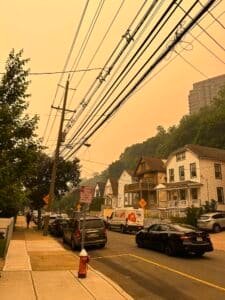
When you open the door, you notice it immediately. That damp, musty smell. You start to look around for signs of puddled water but spot something odd on the wall instead. It’s gross and looks like it’s growing. Must be mildew. Or mold. Wait, aren’t those the same things? Is there a difference?
This scenario and the questions it raises are very common for homeowners. While mildew and mold are similar in some ways, they’re also very different in other, more significant ways. Below, we’ll define mildew and mold, explore their similarities and differences, and discuss the best ways to treat these distinct fungi.
Mildew and Mold Similarities
Mildew and mold are both fungi that thrive in damp areas with lots of moisture. In households, mildew and mold often grow in basements, bathrooms, crawl spaces, ventilation ducts, and any space where moisture collects. Both have a musty, unpleasant odor and can grow on a variety of surfaces such as wood, paper, and leather. If left untreated, mildew and mold can damage homes and may lead to health problems for residents.
Mildew and Mold Differences
Although mildew and mold share the traits listed above, they differ in many ways. Perhaps their most striking difference is their appearance. Mildew is easy to identify on surfaces because it’s flat, white, or gray in color and sometimes it’s even powdery in texture. While it’s found in damp places, mildew thrives on heat and humidity so it typically targets showers, windowsills, or any place that’s more hot and humid than others.
Mold is identified by its raised texture and green, blue, red, or black color. It’s also typified by a fuzzy, slimy appearance. Like mildew, mold has a damp odor but it’s more pungent and even more unpleasant. Of these two fungi, mold is the one that has more cause for concern as it can lead to serious health risks like respiratory problems.
Mildew and Mold Treatment
The biggest commonality of mildew and mold is that they should be eliminated from households immediately. However, the biggest difference between mildew and mold is the way in which they’re removed.
Since mildew grows on surfaces, many cases are easily removed with formulated cleaning products, a scrubbing brush, and some serious elbow grease. Mold on the other hand is more problematic. Unlike mildew, it doesn’t stay solely on the surface. It burrows under the surface and can’t be removed with cleaning products. And since it’s more dangerous to household structures and personal health, it not only requires expert removal techniques, it also requires remediation.
Mold Removal and Remediation
The key to treating household mold infestation is to not only remove the fungus but also to restore natural mold levels. It’s impossible to remove all mold spores from indoor and outdoor environments, but remediation helps keep mold levels safe for households.
After a mold test is performed, technicians identify and locate the “wet spots” where mold is growing and lingering. Once these problem areas have been located, plastic barriers are set up to isolate the affected areas. Next, these areas are treated with negative air using equipment outfitted with high-efficiency particulate air (HEPA) filtration systems. If the mold infestation is severe, technicians remove the damaged sections and replace them.
Specialized paint is then applied to encapsulate the area and prevent mold from establishing another outbreak. If the contamination was severe, additional patching or painting of the affected areas may be necessary.
To ensure that all the mold has been removed, another test is performed. If the results are negative, then the household is free from mold.
Now you know the similarities and differences between mildew and mold and what to do if you encounter mold in your home. If you suspect mold in your home (or you’re unsure that it’s mildew or mold), contact FloodCoUSA to learn how our trained and certified mold removal and remediation experts can help make your home safe again!



